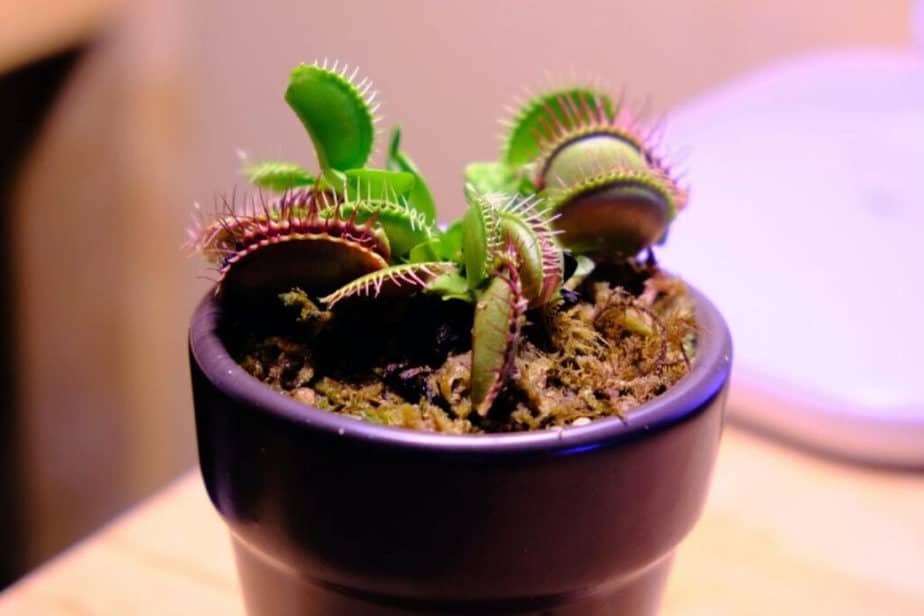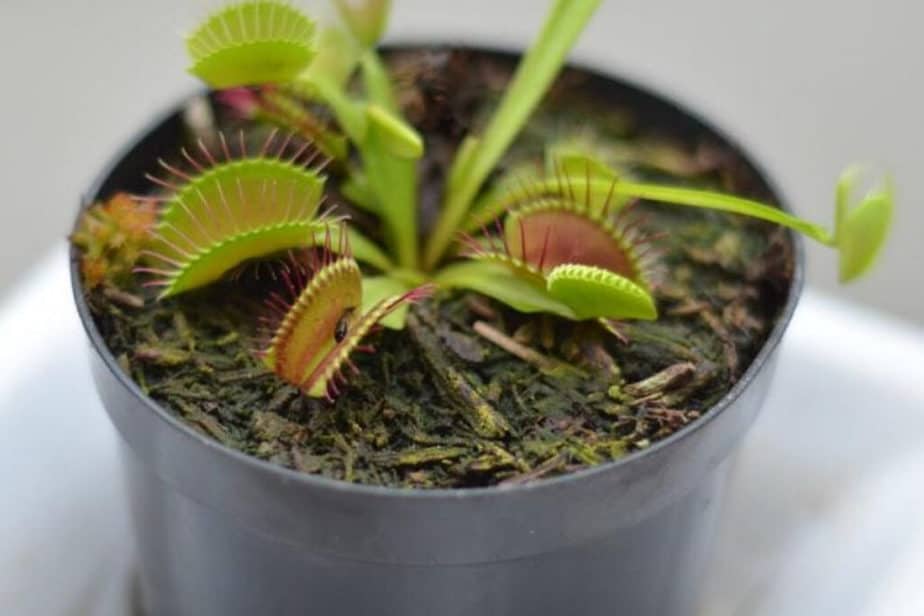If you are a carnivorous plant enthusiast who wants to try growing Venus Flytrap from seed, here is a step-by-step guide.
This care and growing Venus Flytrap from seed guide will help you get optimal environmental conditions and techniques for cultivating your plants directly from seed.
Know that in the Northern Hemisphere, from April to June, Venus Flytraps generally flower and produce seeds. Once harvested, with proper storage, your seeds will be viable for at least a year, if not longer.
How to Grow a Venus Flytrap from Seed
1. Gather the Necessary Items and Tools
Before starting, it’s always best to gather all the items you need first. You will need to have on hand:
- Peat moss or long-fibered sphagnum moss
- Perlite or silica sand
- A container with a cover or transparent plastic
- A tool for poking holes in your container
- A sifter
- Distilled water
- A pressure cooker (optional for sterilizing)
2. Prepare the Soil
Begin by preparing the correct growing medium for your seeds. The soilless substrate will be identical to that which is used for cultivating mature plants or a 1 to 1 ratio of peat moss blended with silica sand.
You can use Perlite instead of silica sand, but the pieces must be very small. You can also substitute peat moss with long-fibered sphagnum.
Never use soil or any type of additives such as fertilizer. Potting soil is not appropriate, nor are Miracle Grow products that contain minerals that will kill your Venus Flytrap plant.
Sterilize the growing medium before sowing seeds to prevent the growth of algae or mold. You can sterilize by placing a pot of soil into your pressure cooker and letting it run for approximately a half-hour until it arrives at pressure.
You can usually find good carnivorous plant soil online too.
3. Prepare the Container
You need to select a container that will ensure seeds and soil remain moist and warm, but that also allows for good air circulation.
You can use a plastic container with a top, such as a Tupperware-type container, plastic dish or box.
Poke drainage holes in the container’s bottom to ensure drainage, and poke holes in the container cover for air circulation and to prevent overheating.
If you do not have a container with a cover, choose what you have and cover it with transparent plastic.

4. Moisten the Growing Medium
Moisten your soilless growing medium, and then place it in your chosen container.
5. Sow Your Seeds
Seeds are not to be buried in the growing medium or underground. Scatter your Venus Flytrap seeds over the dampened soil bed.
Now, using a sifter, sift a very light veil of sphagnum peat moss dust over the seeds. This is to aid in keeping moisture near the seeds and to protect the germinating root from drying out.
Be careful not to cover the seeds or they will not germinate. You should be able to see them through the peat moss dust.
6. Water
Using a spray bottle filled with distilled water, spray the dusted seeds to moisten them. Now cover your container with transparent plastic or a vented lid.
Don’t use tap water, because different cities and municipalities will add chlorine and fluoride to the tap water. It’s always best to use distilled water, filtered water, or rainwater.
Learn more about How to Water Venus Flytraps.
7. Give the Plant Light
The steps above will give you a great germination chamber for your fresh seeds. It needs to be placed in a spot with bright indirect light.
Never place germinating seeds in direct sunlight, or you risk overheating and killing them. As soon as the seeds have germinated, uncover your container.
Very gradually introduce your new seedlings to direct sunlight, by increasing the amount of time a little each day. A mature Venus Flytrap requires a minimum of 4 hours of direct sunlight daily, so work your way up.
You can also choose to use strong fluorescent lights if your area has insufficient sunlight. Read more about Venus Flytrap Grow Lights.
8. Germination Period Care
Germination may last from approximately 13 to 35 days. During this time the soilless growing medium must be kept moist and warm.
To water germinating seeds, use a spray bottle with distilled water to wet the surface and continue spraying to achieve saturation until you see water draining from the bottom of your container.
As an alternative, you can place the container in a dish with distilled water, and the soilless growing medium will suck up the amount of water it needs through the pot’s drainage holes.
The growing medium must always be kept moist, so that germinating seeds have access to sufficient water. Only mineral-free water can be used, meaning distilled water, clean rainwater, or reverse osmosis water.
9. Ensure Humidity and Air Ventilation
Your germination chamber must be kept humid. When the container is covered with a lid or plastic, this is accomplished.
Once a day, lift the lid or plastic and lightly fan the air to freshen it and prevent mold development. Venus Flytraps only require high humidity during germination.

10. Ensure a Warm Environment
The ideal germination temperature for Venus Flytrap seeds is between 78° and 90°F. If you place your seeds in lower temperature environments, they will need 3 to 5 weeks to achieve germination.
If it is too cold, they will not germinate.
11. Transplant the Seedlings
Wait for 2 to 3 weeks for Venus Flytrap seedling growth and then transplant your seedlings into uncovered containers. Transplant when the cotyledons extend fully from the seed. These are the first 2 leaves.
You should also see the first little leaf trap forming. This will indicate that the seed has a base and root so that it can anchor itself into the new growing medium.
Using a toothpick, lower it into the growing medium near the seedling. Lift it out with the root of your seedling intact. Transfer the seedling and root into a small hole in the new and sterilized soilless growing medium.
The leaves should be positioned upward and the base and root down. Lightly adjust the soil around the seedling.
How Long Does It Take for a Venus Flytrap Seed to Germinate?
Venus Fly Trap seeds will normally require 13 to 15 days to germinate in optimal conditions. In cooler temperatures, they can require 21 to 35 days for germination.
How Long Does It Take for a Venus Flytrap to Grow from Seed?
A Venus Flytrap will generally require 2 to 4 years to reach maturity when cultivated from seed. You’ll know it’s reached maturity once it starts to produce flowers. The Venus Flytrap will only bloom once it’s reached maturity.
How Do You Pollinate and Harvest Your Own Venus Flytrap Seeds?
Between the months of February and May, Venus Flytrap flower stalks will grow and bloom. If you have no intention of harvesting seed, it is better to remove flower stalks as they use quite a bit of the plant’s energy. If you wish to pollinate and harvest seeds, let the flower stalks grow and bloom.
The Venus Flytrap flowers are only open to pollination for 1 to 1.5 days after the flower opens. Blooms should be pollinated with the fresh pollen of a younger bloom that has just opened.
Using a very small artist’s paintbrush, brush the antennae or antlers seen around the flower’s yellow fuzzy stigma found at the bloom’s center. Preferably, choose the youngest or most recently opened bloom. Transfer the pollen on the brush to the stigma of a bloom that is 1 to 1.5 days from its opening.
When the flower has been pollinated, the flower petals will curl inward and if successful, the base of the flower will swell. Seed pods will swell as the seed inside develops.
After some time, the seed pods will dry and crack open, revealing black seeds. Mature seeds, approximately 1 mm. in size, will fall from the pods.
To save your seeds from falling, snip off the ripened opened pods that reveal the black seeds and place them in a box top or over a paper towel to avoid losing them.
Seed pods generally ripen from August through September. Once you have gathered the tiny black seeds, let them dry in the air for several days.
Then place them in a plastic bag and keep them in the refrigerator. They should keep for up to a year.
Growing Venus Flytraps from Seed Final Thoughts
Growing your own Venus Flytraps from seed is not difficult but requires patience and dedication. The process can take anywhere between 3 and 5 years depending upon environment conditions and how well you care for the plants.
Here are other Venus Flytrap articles you might be interested in:

